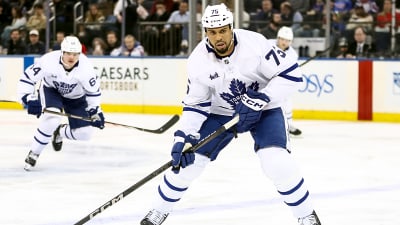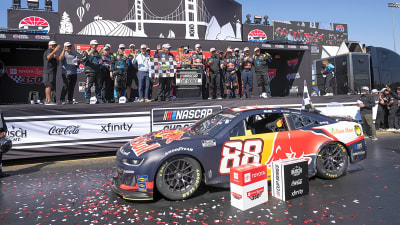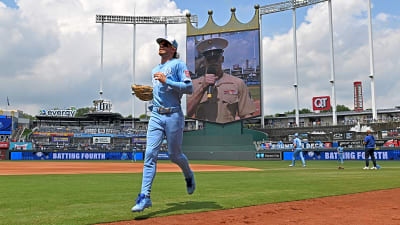- Home
- Quizzes
- My Quiz Activity
- Newsletters
- MY FAVORITES
- Add Sports/Teams
- SPORTS
-
NFL
- NFL Home
- Arizona Cardinals
- Atlanta Falcons
- Baltimore Ravens
- Buffalo Bills
- Carolina Panthers
- Chicago Bears
- Cincinnati Bengals
- Cleveland Browns
- Dallas Cowboys
- Denver Broncos
- Detroit Lions
- Green Bay Packers
- Houston Texans
- Indianapolis Colts
- Jacksonville Jaguars
- Kansas City Chiefs
- Las Vegas Raiders
- Los Angeles Chargers
- Los Angeles Rams
- Miami Dolphins
- Minnesota Vikings
- New England Patriots
- New Orleans Saints
- New York Jets
- New York Giants
- Philadelphia Eagles
- Pittsburgh Steelers
- San Francisco 49ers
- Seattle Seahawks
- Tampa Bay Buccaneers
- Tennessee Titans
- Washington Commanders
-
MLB
- MLB Home
- Athletics
- Arizona Diamondbacks
- Atlanta Braves
- Baltimore Orioles
- Boston Red Sox
- Chicago White Sox
- Chicago Cubs
- Cincinnati Reds
- Cleveland Guardians
- Colorado Rockies
- Detroit Tigers
- Houston Astros
- Kansas City Royals
- Los Angeles Angels
- Los Angeles Dodgers
- Miami Marlins
- Milwaukee Brewers
- Minnesota Twins
- New York Yankees
- New York Mets
- Philadelphia Phillies
- Pittsburgh Pirates
- San Diego Padres
- San Francisco Giants
- Seattle Mariners
- St. Louis Cardinals
- Tampa Bay Rays
- Texas Rangers
- Toronto Blue Jays
- Washington Nationals
-
NBA
- NBA Home
- Atlanta Hawks
- Boston Celtics
- Brooklyn Nets
- Charlotte Hornets
- Chicago Bulls
- Cleveland Cavaliers
- Dallas Mavericks
- Denver Nuggets
- Detroit Pistons
- Golden State Warriors
- Houston Rockets
- Indiana Pacers
- Los Angeles Clippers
- Los Angeles Lakers
- Memphis Grizzlies
- Miami Heat
- Milwaukee Bucks
- Minnesota Timberwolves
- New Orleans Pelicans
- New York Knicks
- Oklahoma City Thunder
- Orlando Magic
- Philadelphia 76ers
- Phoenix Suns
- Portland Trail Blazers
- Sacramento Kings
- San Antonio Spurs
- Toronto Raptors
- Utah Jazz
- Washington Wizards
-
NHL
- NHL Home
- Anaheim Ducks
- Boston Bruins
- Buffalo Sabres
- Calgary Flames
- Carolina Hurricanes
- Chicago Blackhawks
- Colorado Avalanche
- Columbus Blue Jackets
- Dallas Stars
- Detroit Red Wings
- Edmonton Oilers
- Florida Panthers
- Los Angeles Kings
- Minnesota Wild
- Montreal Canadiens
- Nashville Predators
- New Jersey Devils
- New York Islanders
- New York Rangers
- Ottawa Senators
- Philadelphia Flyers
- Pittsburgh Penguins
- San Jose Sharks
- Seattle Kraken
- St. Louis Blues
- Tampa Bay Lightning
- Toronto Maple Leafs
- Utah Mammoth
- Vancouver Canucks
- Vegas Golden Knights
- Washington Capitals
- Winnipeg Jets
- NCAAF
- NCAAM
- Olympics
- Boxing
- Entertainment
- Lifestyle
- Golf
- MMA
- Soccer
- Tennis
- Wrestling
- Sports Betting
- More Sports
- RESOURCES
- My Account
- YB on Facebook
- YB on Twitter
- YB on Flipboard
- Contact Us
- Privacy Policy
- Terms of Service
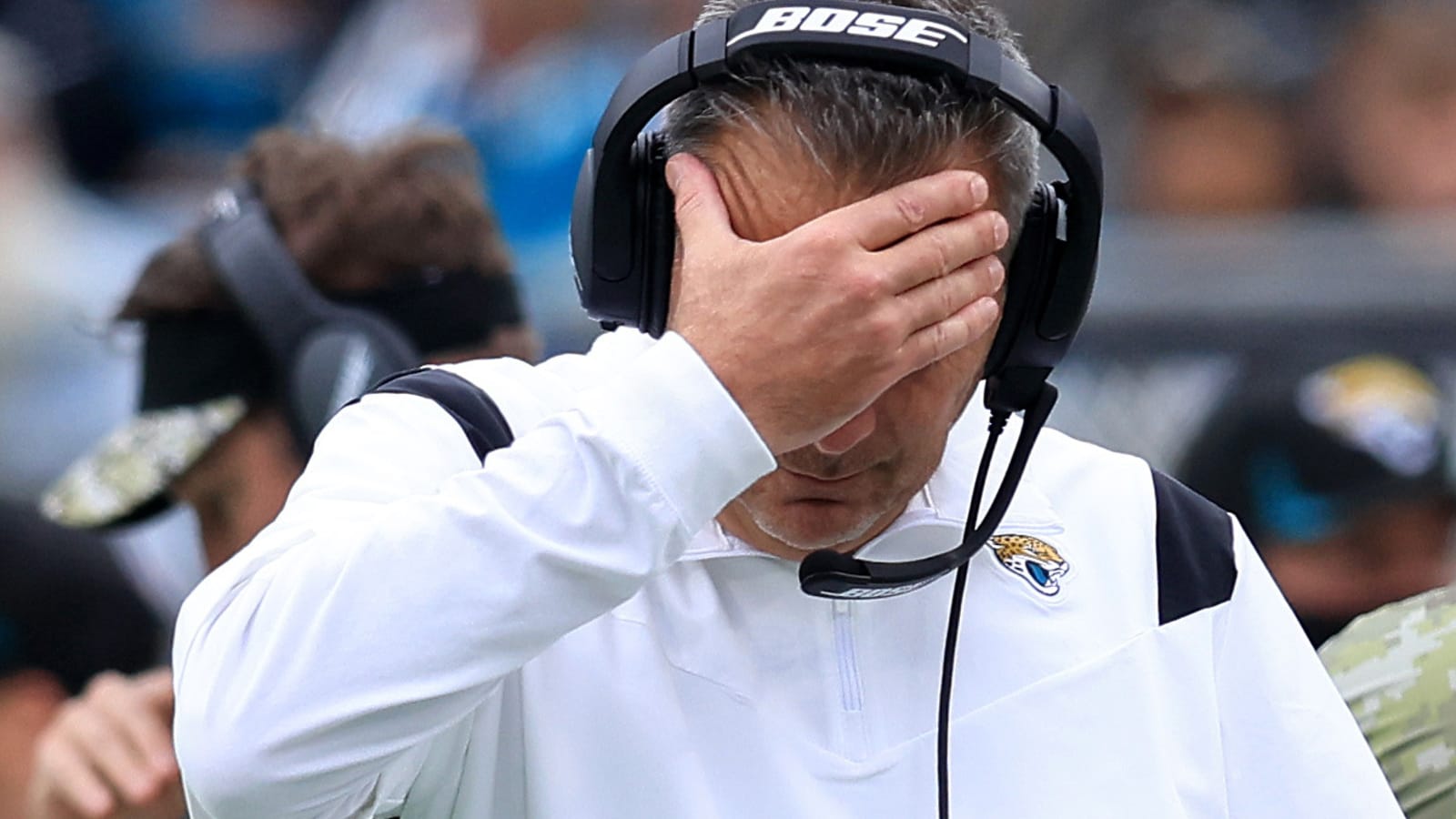
One-and-done: NFL head coaches who only lasted one season
Early firings of head coaches are becoming more common in the NFL, but quick triggers have been pulled for decades. Although many different stories exist behind teams' one-and-done decisions, more than 40 instances of a club cutting bait after one season have occurred. Here are the NFL's one-and-done coaches in the Super Bowl era. Note: this includes coaches of the Antonio Pierce variety and interim leaders who earned the full-time job but did not keep it beyond Year 1.
Jerod Mayo, New England Patriots (2024)
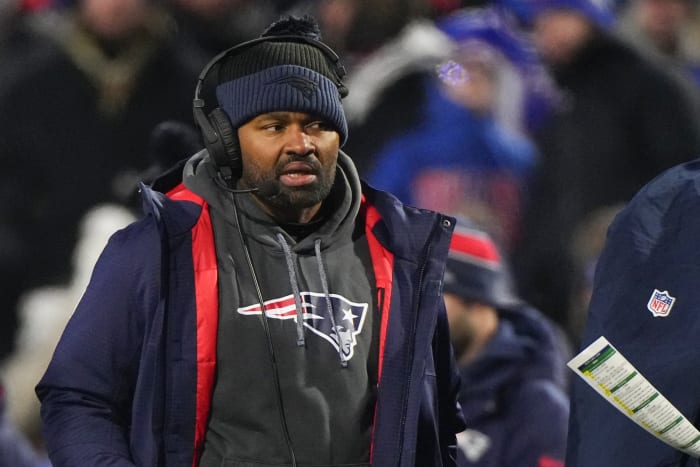
Robert Kraft said he came up with the Mayo succession plan years ago, but the Patriots owner erred by not conducting a proper search. Kraft merely inserted language into Mayo's contract to effectively circumvent the Rooney Rule, making the ex-Patriots linebacker-turned-assistant Bill Belichick's successor-in-waiting. The Pats' plan was for Mayo to take over in 2025, however, and they found Mayo ultimately unready for the gig in 2024. The Patriots went 4-13 for a second straight season, but Mayo did not run a buttoned-up operation. A contrite Kraft pulled the plug and hired Mike Vrabel, who would have been a logical 2024 choice had the Pats held an actual search.
Antonio Pierce, Las Vegas Raiders (2024)

Pierce is the first example of a team elevating an interim coach to full-time status and then firing him after one season in over 10 years. The Raiders hired the ex-linebacker, who profiled as an unusual candidate due to being neither a former NFL coordinator nor an ex-college head coach. Like Mayo, Pierce appeared unready. The Raiders lost 10 straight after a 2-2 start, finishing 4-13, trading Davante Adams and firing their OC (Luke Getsy). Pierce drew the short straw, in seeing the Raiders fail to equip him with a starter-level QB. The Gardner Minshew-Aidan O'Connell duo played the lead role in sinking him, as part-owner Tom Brady also booted GM Tom Telesco after one year.
Frank Reich, Carolina Panthers (2023)

Seeking an offense-oriented coach rather than remove Steve Wilks' interim tag after a promising 2022 finish, David Tepper hired Reich shortly after his Colts ouster. The impulsive owner grew to regret it, firing Reich after 11 games. The historically quick hook came after the Panthers started 1-10. Reich attempted to combine concepts from his playbook and Sean McVay's, with ex-Rams staffer Thomas Brown yo-yoing as the play-caller. This mess of a season stunted No. 1 overall pick Bryce Young's growth, as the Panthers' offseason plan gave the rookie QB little in terms of weaponry. The team finished 2-15, and Reich appears ready to stick with a retirement plan.
Nathaniel Hackett, Denver Broncos (2022)

The 2022 Broncos offseason is among the worst teams have submitted this century. Three of the worst personnel moves -- hiring Hackett, trading for Russell Wilson and then extending him -- defined it. Hackett was immediately overmatched, letting Wilson and his camp run amok to the point the QB gained weight and tried to act as a pure pocket passer. Hackett tripped alarms early by halting a potential go-ahead drive for a 64-yard field goal attempt in Week 1, and his gameday issues prompted the Broncos to force a game-management coach on him by Week 3. A disjointed offense brought a shocking Wilson decline, and a last-place freefall. The Broncos fired Hackett after a Christmas blowout loss.
Lovie Smith, Houston Texans (2022)

Texans GM Nick Caserio assembled an odd plan to start his tenure, hiring two off-grid coaches and not making much of an effort to stock the roster with talent. Smith received a better team than one-and-done predecessor David Culley, but the results were worse. Houston finished 3-13-1, with Smith the rare coach to (perhaps smartly) play for a tie -- in a Week 1 Colts matchup. As the season deteriorated, Smith may well have seen the writing on the wall. To close the season, the former Bears and Buccaneers HC greenlit a game-winning two-point conversion to beat the Colts. This cost the Texans the No. 1 overall pick, as Smith slunk out the door.
David Culley, Houston Texans (2021)

Not dealt good cards, Culley also was not on any other team's radar when Caserio hired him. Hired at 65, Culley had never been a coordinator at the college or pro levels. The Ravens wide receivers coach was at the helm during Deshaun Watson's awkward final year in Houston, as the Texans made the QB -- after a trade demand and numerous sexual misconduct allegations -- a healthy scratch throughout the season. Davis Mills fared better in 2021 than he did in 2022, but an outgunned Texans roster finished 4-13 before Culley received the early boot. Culley has not coached since.
Urban Meyer, Jacksonville Jaguars (2021)

One of the most disastrous hires in NFL history , Meyer cast a bad light on Jaguars ownership. Shad Khan gave the former college icon full autonomy, and Meyer was not suited for the pro game. He displayed poor knowledge of the NFL, disparaged his assistants, was accused of kicking kicker Josh Lambo before a game and infamously did not travel home with his team from a game in Cincinnati. Meyer was soon seen enjoying himself in an Ohio bar. More importantly, the poor environment brought a wasted year for high-end prospect Trevor Lawrence, who threw one TD pass between Halloween and New Year's Day. Khan begrudgingly fired Meyer after a 2-11 start.
Freddie Kitchens, Cleveland Browns (2019)
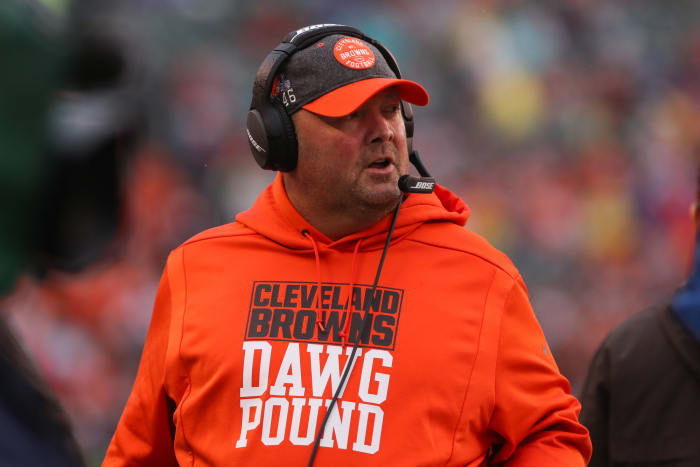
When the Browns mercifully ended Hue Jackson's tenure in 2018, disgraced defensive coordinator Gregg Williams moved into the HC role as Kitchens climbed to OC. Cleveland's new play-caller appeared to unlock something in Baker Mayfield, and GM John Dorsey gave him the top job the next year. The ensuing Odell Beckham Jr. trade added to the Mayfield-driven hype, but the Browns became a cautionary tale. Highlighted by Myles Garrett's suspension for the Mason Rudolph helmet strike, the 2019 Browns season ended at 6-10. Mayfield threw 21 INTs, and the team faced questions about a lack of preparedness and discipline. This T-shirt effectively encapsulated Kitchens' lack of readiness for the stage.
Steve Wilks, Arizona Cardinals (2018)

The Cardinals plummeted from 8-8 in Bruce Arians' finale to 3-13 under Wilks, but this one-and-done looks a bit shaky in hindsight. Not fielding a good roster, this Arizona edition bet big on No. 10 overall pick Josh Rosen. As the 2018 first-round QB class had four of its five members starting in the NFL in 2024, Rosen has been long out of the league. The UCLA product struggled behind a bad O-line, and future Hall of Famer Larry Fitzgerald played 16 games and finished with 734 receiving yards. Wilks' defense did not fare too much better. After the Steve Keim- Michael Bidwill burner phone scandal , Wilks joined Brian Flores' class-action discrimination lawsuit.
Chip Kelly, San Francisco 49ers (2016)
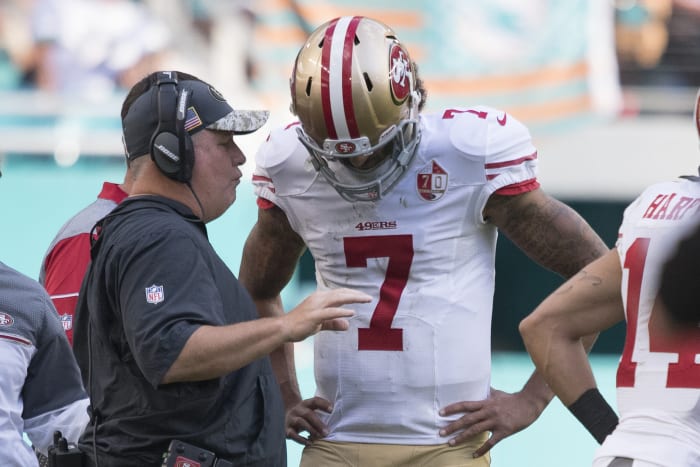
This season may be discussed for a while, though such talks rarely delve too deeply into the 49ers' 2-14 record. This was Colin Kaepernick's final NFL season. The former Super Bowl starter-turned-blackballed QB went 1-10 as a starter under Kelly, the former Oregon coach coming off an eventfully bad year as the Eagles' de facto GM. Kelly had posted two 10-win seasons as Eagles HC, before a rough 2015 did him in, and he flamed out after the 49ers ranked last defensively and could not restore Kaepernick to his Jim Harbaugh-era heights. Jed York hired Kyle Shanahan to overhaul this mess, and owners deemed Kaepernick persona non grata after his racially motivated anthem protest.
Jim Tomsula, San Francisco 49ers (2015)

In a season that helped show Harbaugh's value, Tomsula proved overmatched. A feud between the successful head coach and GM Trent Baalke ended with Harbaugh, despite three straight NFC championship game berths, headed to Michigan. Baalke promoted Tomsula, the 49ers D-line coach, and saw the team's downfall accelerate. The 49ers went 5-11 and ranked last offensively. Blaine Gabbert beat out Kaepernick for the team's starting job and ultimately outplayed the recently extended QB. No 49ers running back cleared 500 yards. Admittedly put in a bad spot with a declining team, Tomsula has not been a coordinator since while Harbaugh has enjoyed success elsewhere.
Rob Chudzinski, Cleveland Browns (2013)

Jimmy Haslam bought the Browns in 2012 and fired holdover coach Pat Shurmur. He made Chudzinski his first hire. The Ohio native had enjoyed two previous Browns stints, one as OC for a 10-6 2007 team, and oversaw Cam Newton's Offensive Rookie of the Year season in 2011. He walked into a Cleveland setup with Brandon Weeden in his age-30 season despite being drafted in the 2012 first round as the initial starting QB. The Browns did well to trade Trent Richardson for a first-round pick, before the RB bust's value cratered, and Chudzinski coaxed a first-team All-Pro season from embattled WR Josh Gordon. But the team went 4-12 and fired everyone, with the next regime being responsible for the Johnny Manziel pick.
Romeo Crennel, Kansas City Chiefs (2012)

Part of Bill Belichick's NFL legacy will be his assistants' collective failures elsewhere. Years after his Browns HC stay, Crennel replaced Todd Haley as an interim coach in 2011. That Chiefs team handed the Packers their only regular-season loss that year. This booked Crennel a true shot; his team went 2-14. Sunk-cost QB Matt Cassel and ex-Browns bust Brady Quinn -- who was with Crennel in Cleveland -- took the snaps, helping a Chiefs team with six Pro Bowlers (Jamaal Charles and Tamba Hali among them) faceplant. The season ended with the horrifying Jovan Belcher situation at Arrowhead Stadium. The team hired Andy Reid weeks later.
Mike Mularkey, Jacksonville Jaguars (2012)

Shad Khan's first coaching hire, Mularkey went 2-14 in his second shot as a head coach. He took over a team with a bust-in-training (Blaine Gabbert) at quarterback and a top-five wide receiver draftee (Justin Blackmon) who was effectively banned for life for substance abuse after his 2012 rookie year. Gabbert went 1-9 before being benched and relocated to the QB2 tier henceforth, while reigning rushing champion Maurice Jones-Drew played just six games. No Jaguar topped 3.5 sacks, as the defensive side also cratered. Both Mularkey, who managed to land a third chance with the Titans, and GM Gene Smith were fired after this unraveling.
Hue Jackson, Oakland Raiders (2011)
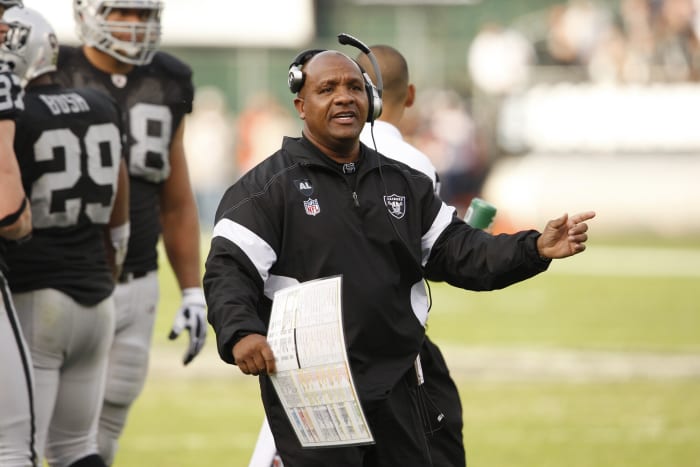
One of the least successful head coaches in NFL history, Jackson did receive a bit of a raw deal in Oakland. He had a low-talent Raiders team at 8-8, losing a tiebreaker to the Tim Tebow-led Broncos for the AFC West title. Hired months before Al Davis' death, Jackson was at the wheel during a stretch where the Raiders lacked a true GM. Jackson stepped in during that period, and the team traded first- and second-round picks for Carson Palmer at the deadline. The talented passer did not impress to start a brief stay. Oakland's defense ranked 29th, and new GM Reggie McKenzie canned Jackson on his first day. McKenzie's first hire, Dennis Allen, brought a significant step back.
Jim Mora Jr., Seattle Seahawks (2009)

The Seahawks' Mike Holmgren succession plan involved elevating their DBs coach, but Mora's 5-11 record left ownership dissatisfied. The Seahawks improved by a game from 2008, but lost their final four contests. This ouster may well have been motivated by Pete Carroll eyeing an NFL return. The USC coach had rebuilt his stock since flaming out in New England, winning two national titles, and received full control of football operations. He also had the chance to effectively pick his GM -- John Schneider, who ultimately outlasted him in Seattle. Mora, the former Falcons HC, focused on the college game after his exit.
Bobby Petrino, Atlanta Falcons (2007)
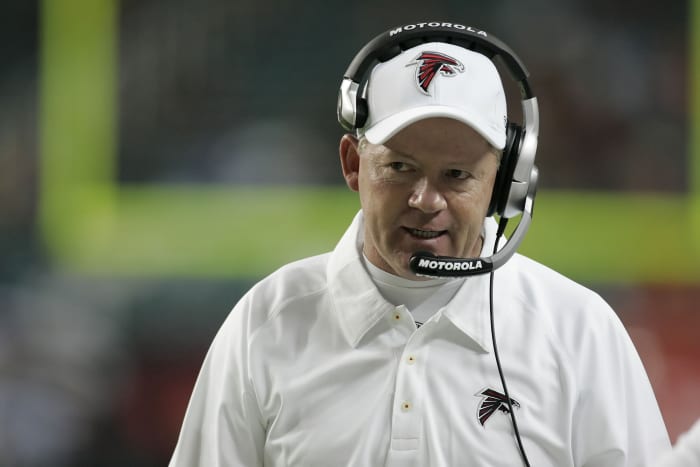
Taking over a job expected to include Michael Vick at quarterback, Petrino soon led a team in purgatory after Vick's dogfighting scandal produced a suspension and prison sentence. After coming over from the college ranks, Petrino coached a team with Joey Harrington as its primary passer. The Falcons ranked 29th on offense and defense. Petrino denied rumors he would return to the college game as the season wound down. In mid-December, however, the ex-Louisville coach backtracked to take over at Arkansas. Vick was not sentenced until December; that verdict came days before Petrino bailed on the NFL. Atlanta finished 4-12, keying a Matt Ryan draft choice.
Art Shell, Oakland Raiders (2006)

Shell went 56-41 during his first tenure as Raiders HC (1989-94) but had been out of the NFL six years when Al Davis hired him. Shell was far from the first choice, and it showed. Oakland finished 2-14 despite housing a No. 3-ranked defense. A 29-year-old Randy Moss totaled 553 yards in 13 games, and Shell buried wideout regular Jerry Porter on the depth chart. Shell's OC to close his first stint, Tom Walsh, was running a bed and breakfast upon being rehired; he had not coached in the NFL since 1994. These Raiders also housed future Hall of Famer Warren Sapp, adding to this bizarre mess. They traded Moss for a fourth-round pick and drafted JaMarcus Russell the following April.
Marty Schottenheimer, Washington (2001)

As his Browns and Chargers departures showed , Schottenheimer had a history of exits after seasons that did not exactly warrant firings. This one came after an 8-8 slate, and Dan Snyder -- in season two as owner -- had coveted target Steve Spurrier ready as a replacement. The Spurrier allure doomed Schottenheimer, whose offense -- run by previously benched Ravens QB Tony Banks -- ranked 28th. A few of Snyder's aging cogs from the 2000 spending spree (Deion Sanders, Mark Carrier, Andre Reed) were already gone. Schottenheimer closed his tenure by firing several Norv Turner assistants, but he and Snyder then disagreed on who would control personnel. "Martyball" moved to San Diego in 2002.
Al Groh, New York Jets (2000)

Technically, Bill Belichick could be considered here, as he beat Groh to resigning his post. Bill Parcells' supposed successor left for what he deemed a better deal, with the Patriots, and left the rivals haggling over draft compensation. A former Parcells and Belichick assistant, Groh had been the Jets' linebackers coach. His tenure started well, with four straight wins, but the team ended 9-7 and out of the playoffs. Groh lost top receiver Keyshawn Johnson via trade, but his team made a record four first-round picks as a result. This season also featured a miraculous Monday-night comeback against the Dolphins, but Groh left for alma mater Virginia days after the campaign.
Ray Rhodes, Green Bay Packers (1999)

After four seasons as Eagles HC, Rhodes received a rebound chance with the Packers. Having worked with Mike Holmgren in San Francisco and then Green Bay, Rhodes was a logical successor after the Pack traded their Super Bowl-winning coach's rights to the Seahawks, who were giving trade acquisition personnel control. Rhodes went 8-8, marking the Packers' first missed playoff bracket since 1992, and his final game featured an unusual duel with the Panthers to win a net points tiebreaker -- sadly, the NFL has done away with such sequences thanks to rule changes. This season also came after Reggie White's first retirement, wounding Rhodes' defense.
Joe Bugel, Oakland Raiders (1997)
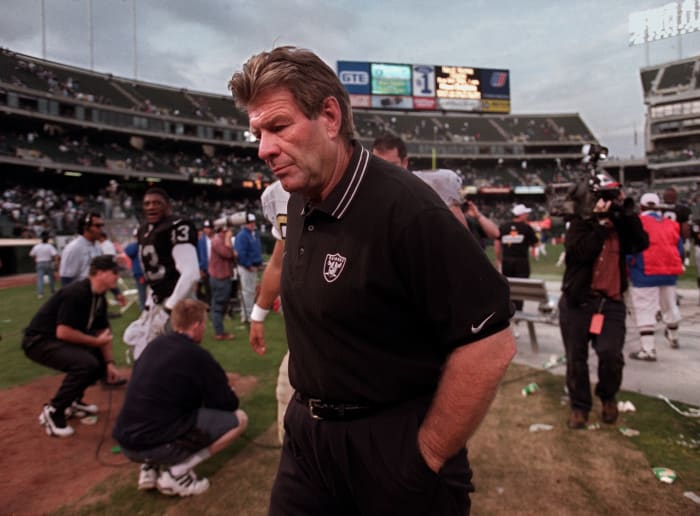
Going 0-for-4 in playoff berths with the Cardinals, Bugel booked a second chance nonetheless. It did not go well, as these Raiders finished 4-12. Al Davis promoted Bugel to replace Mike White, whom he had fired after two seasons, and the move did produce Tim Brown's best statistical season (1,408 yards) and an explosive showing from RB Napoleon Kaufman (1,294 on the ground). Jeff George also posted a 29-9 TD-INT ratio. An anemic defense did in Bugel, a formerly well-regarded O-line coach in Washington. He later returned to the nation's capital, after a Chargers stint, and Davis staved off a full-on decline by hiring Jon Gruden.
Pete Carroll, New York Jets (1994)

One of the NFL's more notable "be careful what you wish for" moments took place in December 1994, when owner Leon Hess subbed out Carroll for ex-Jets assistant Rich Kotite. Pre-Rooney Rule, hires could be expedited, and the Jets made one by adding the fired Eagles HC. Ownership canned Carroll after a 6-10 season in the immediate aftermath of a five-game losing streak that began after the Dan Marino fake-spike play. The Jets blew a 24-6 second-half lead to the Dolphins at home in Week 13, and tumbled out of the playoff race. The easygoing Carroll later won three titles, including Super Bowl XLVIII, while Kotite was fired after a 2-14 1996 season.
Richie Petitbon, Washington (1993)
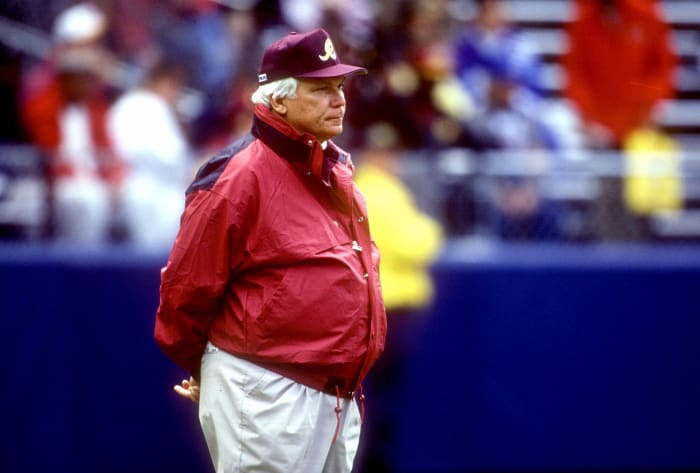
Joe Gibbs' defensive coordinator, Petitbon was effectively set up to fail upon taking over an aging team. While owner Jack Kent Cooke and GM Charley Casserly took issue with Petitbon's more relaxed methods compared to Gibbs', injuries and a core trending downward two years after the Super Bowl XXVI win led to a 4-12 season. Washington had not lost fewer than nine games during Gibbs' 12-year tenure, and the Hall of Famer's exit to lead a NASCAR team damaged the organization. Super Bowl MVP Mark Rypien threw four TD passes in 10 games, Art Monk's age-36 season, and Petitbon's defense regressed from a 1992 playoff season as well.
Richard Williamson, Tampa Bay Buccaneers (1991)

Amid one of the worst stretches any NFL franchise has trudged through, the Buccaneers canned Williamson a year after he had taken over for Ray Perkins midseason. The ex-Tampa Bay wide receivers coach went 3-13, as Vinny Testaverde's early prime continued to be squandered. Despite spawning in 1976, the Bucs already had six seasons of three or fewer wins as of 1991. Hugh Culverhouse had resided as an unpopular owner, and his bid to lure Bill Parcells to Tampa days after the Williamson firing failed. Parcells turned the job down a year after Bill Walsh was linked to the gig Williamson ended up taking. Williamson remained an NFL assistant until 2009.
Rod Rust, New England Patriots (1990)

Elevated from longtime defensive coordinator to head coach, Rust went from helming a Super Bowl team's defense to overseeing the third-worst point differential in NFL history. New England went 1-15, lost 11 games by double digits and was outscored by 265 points. Beyond that, the sexual harassment scandal involving reporter Lisa Olson led to punishment for the Patriots organization and three of its players. The Pats ranked last offensively, and Rust's defense placed 27th. This brought the team to its nadir, as the final years of the Pat the Patriot logo presented a putrid product that led incoming owner Robert Kraft to hire Bill Parcells.
Les Steckel, Minnesota Vikings (1984)
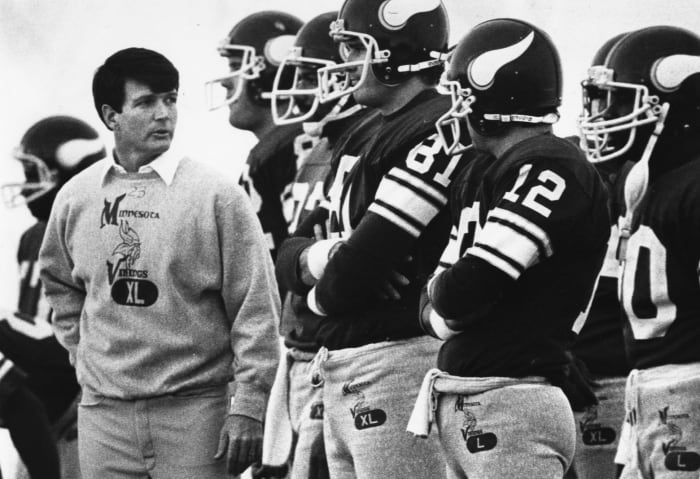
Bud Grant's retirement after the 1983 season turned out to mark a warning sign from the coaching legend, who returned to his post in 1985. What amounted to a Grant sabbatical featured Steckel in command. Steckel climbed from wide receivers coach, over longtime OC Jerry Burns, to replace Grant. The NFL's youngest coach in 1984, at 38, Steckel became unpopular with players for strenuous workout demands. The 3-13 Vikes ranked 24th offensively and last on defense. They lost six straight by double digits to close the season. Grant moved from consultant to HC in 1985; Burns took over and began a turnaround in '86.
Homer Rice, Cincinnati Bengals (1979)
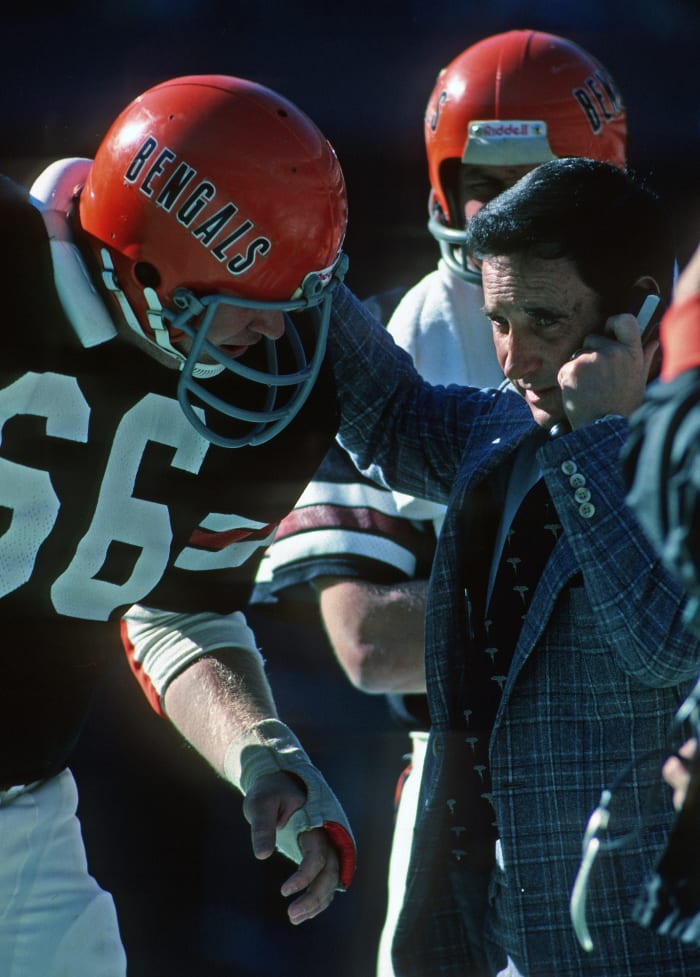
One of the great what-ifs in NFL history transpired in 1976, when a retiring Paul Brown bypassed assistant Bill Walsh to give the Bengals HC job to Bill Johnson. As Walsh regrouped elsewhere ahead of his 49ers renaissance, the Bengals' fortunes worsened. Johnson resigned during the 1978 season, moving Rice -- Cincinnati's QBs coach -- into the top job. Prior to 1978, Rice had only coached in college. The former Cincy and Rice, believe it or not, coach went 4-7 in 1978 but 4-12 in '79. Ken Anderson was regressing post-Walsh, but the Bengals defense's last-place ranking played the lead role in this undoing. Still on as owner, Brown called the need for a coaching change "obvious."
Pete McCulley, San Francisco 49ers (1978)
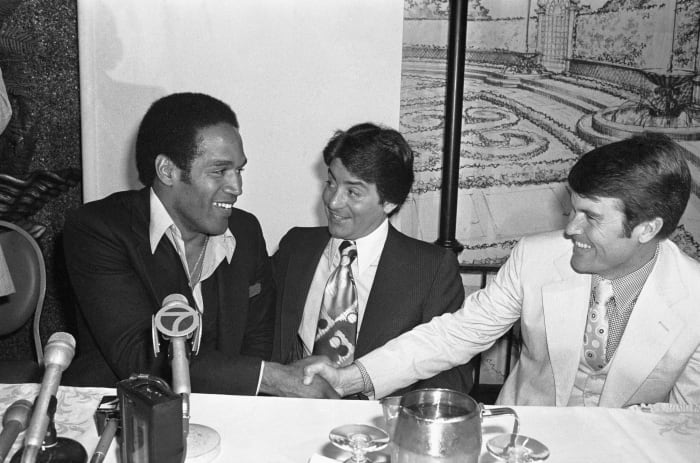
We come to a turbulent 49ers period. Three straight one-and-dones are here -- four if interim coach Fred O'Connor counts. O'Connor became needed early, as the 49ers fired McCulley nine games into his tenure. That marks the earliest a team has fired a first-year coach since the merger. Embattled GM Joe Thomas, who sacrificed considerable draft capital in a sunk-cost O.J. Simpson, had moved on from coaches after the 1976 and '77 seasons. In '78, the 49ers were 1-8 under McCulley -- who came over from Washington -- and finished 2-14. They traded five draft picks for Simpson that March. By January 1979, Thomas was out and Walsh rode in to the rescue.
Tommy Hudspeth, Detroit Lions (1977)

Hudspeth's career included only two seasons in the NFL; both came with the Lions. Detroit turned to the former college, CFL and World Football League coach five games into the 1977 season, firing fourth-year HC Rick Forzano. Hudspeth, who had coached BYU for eight seasons and UTEP for two more, went 5-5 to close the 1976 season and signed a three-year extension in 1977. The Lions did not share similar enthusiasm after the '77 slate, despite Hudspeth going 6-8. The team lost three of its final four games, and ownership hired former 49ers coach Monte Clark, who stayed on for seven seasons.
Ken Meyer, San Francisco 49ers (1977)

Meyer's 1977 hire marked a reunion, as he had been a 49ers assistant in 1968. The 49ers added Meyer after a four-year run as Rams offensive coordinator, but the veteran assistant could not turn Jim Plunkett -- acquired for a historic trade package in 1976 -- work as a starter. The 49ers started 0-5, won their next four during a 5-9 season. Despite Gold Rush sack artists Cleveland Elam and Cedrick Hardman combining for 30 to spearhead a No. 3-ranked defense, the team's offensive struggles interfered. GM Joe Thomas again parted with a coach, hiring McCulley. Meyer resurfaced in prominent roles with the Bears and Seahawks.
Jim Ringo, Buffalo Bills (1977)
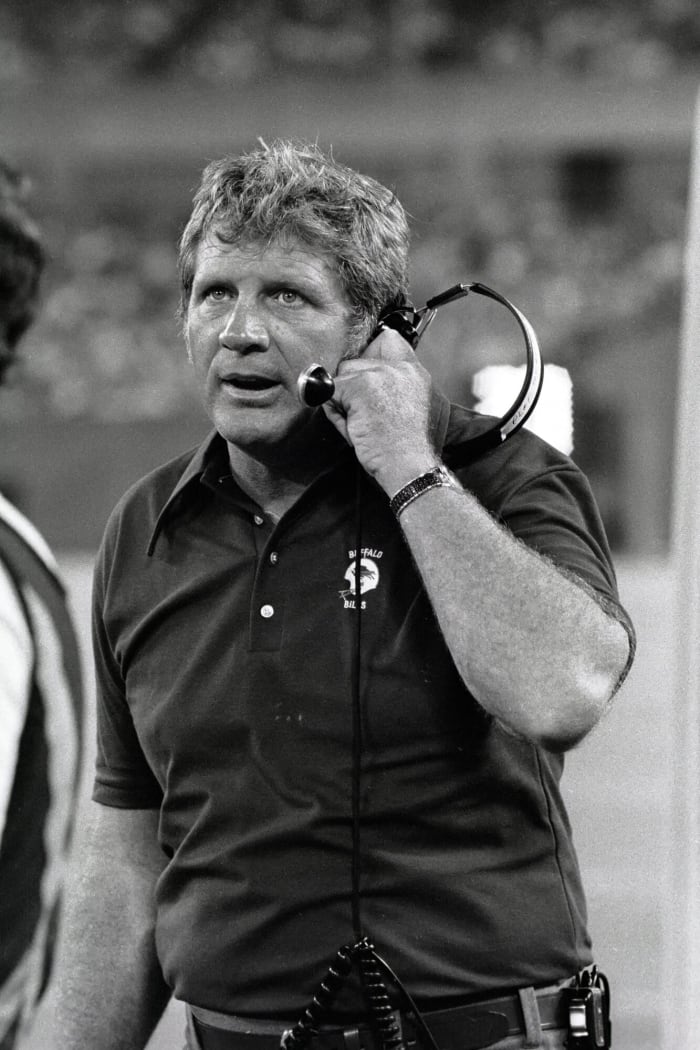
Lou Saban's second stint as Bills coach ended with a resignation five games into the 1976 season, ushering in a rough Ringo stretch. A Hall of Fame center, Ringo went 0-9 to close out the '76 campaign and then went 3-11 in '77. Buffalo managed to go winless despite O.J. Simpson leading the NFL in rushing in 1976; by '77, Simpson's prime was over. Buffalo's centerpiece player missed seven games due to injury, leading to a shift toward the pass. Joe Ferguson led the NFL with 2,803 passing yards but sported a 12-24 TD-INT ratio. Ringo remained a high-level assistant and circled back to the Bills, being their OC when the Jim Kelly-fronted dynasty launched in the late 1980s.
Monte Clark, San Francisco 49ers (1976)

In a move that sent the 49ers toward the NFL's basement, new ownership hired ex-Colts GM Joe Thomas for the same role. A polarizing figure around the NFL at the time, Thomas had clashed with several coaches in the past. He butted heads with Clark upon taking over to start the 1977 offseason. Hired after a successful tenure under Don Shula in Miami, Clark coached the 49ers to a bounce-back season, running the record to 8-6. The team started 6-1, despite Plunkett not justifying a trade that cost three first-round picks, and Clark -- a former O-line coach -- helped the 49ers to a third-place rushing ranking. The ensuing clash with Thomas over personnel control prompted Clark to leave, later resurfacing in Detroit.
Lou Holtz, New York Jets (1976)

Later admitting the NFL was not for him, Holtz made the Bobby Petrino move three decades earlier. The Jets had hired Holtz after a stint as NC State's head coach; they went 3-10 under the future national champion leader. Stepping in as an injury-plagued Joe Namath played his final season as a Jet, Holtz put a college touch on the roster with efforts like composing a fight song and having players line up by height during the national anthem. Holtz's team beat only the two-win Bills and 0-14 Buccaneers, and he bailed before the season finale to take an Arkansas offer. The successful college HC never returned to the NFL.
Don McCafferty, Detroit Lions (1973)
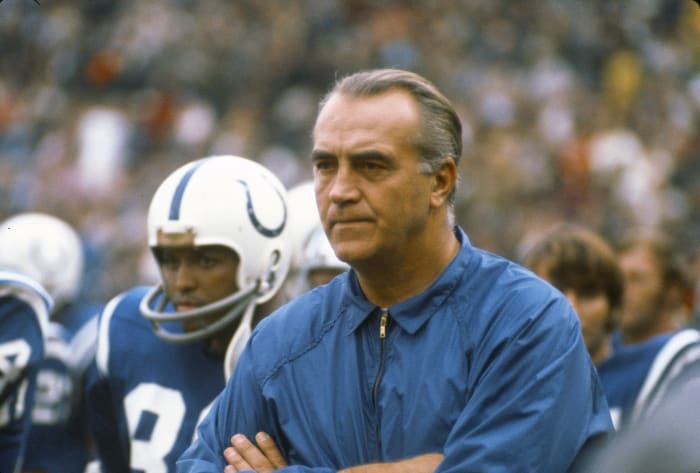
Joe Thomas had fired McCafferty during the 1972 season, as a franchise -- after a 1972 transaction in which the Rams and Colts owners traded teams -- he led to a Super Bowl V win transitioned to a quick rebuild . This led the Lions to swoop in months later. McCafferty worked under Hall of Famers Weeb Ewbank and Don Shula during an 11-season Colts run and had the Lions at 6-7-1 in his first season in Detroit. The Lions tallied mid-pack offensive and defensive finishes and were moving forward with McCafferty for a second season. Tragically, the veteran coach died of a heart attack in July 1974. He was 53.
Ed Khayat, Philadelphia Eagles (1972)

This is an interesting case, as Khayat was only at the beginning of his NFL tenure when the Eagles needed an interim coach. Firing Jerry Williams after just three games in 1971, the Eagles went 6-4-1 under Khayat. The defense-oriented leader performed one of the better interim coaching jobs ever. That magic faded by 1972, when Philadelphia went 2-11-1. This came despite shifty wideout Harold Jackson leading the NFL in receiving and safety Bill Bradley pacing the league with nine INTs. The Eagles, however, started 0-5 and then lost their final five games. The QB-starved team acquired Roman Gabriel soon after. Khayat was an NFL D-line coach until 1993.
Ed Hughes, Houston Oilers (1971)
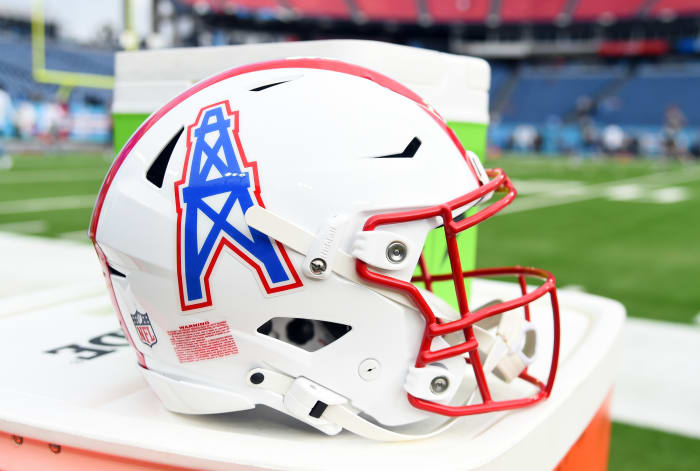
After a 4-9-1 season, the Oilers fired Hughes due to a seemingly minor issue involving the training staff. After an offensive coordinator stay in San Francisco, Hughes trekked to Houston to coach a team with an interesting roster. Future Hall of Famers Elvin Bethea, Charlie Joiner and Ken Houston were either entering their primes or had yet to do so, but an incomplete roster posed a problem. Second-year QB Dan Pastorini struggled, and Oiler QBs posted a combined 12-37 TD-INT ratio. Even in a rough era for passing, that was abysmal. After firing Hughes, the Oilers won a bidding war for Bill Peterson, who proceeded to go 1-18 as Houston's HC.
Harvey Johnson, Buffalo Bills (1971)

Technically a one-and-done, no coach logged more time in that role on this list. Johnson coached 12 Bills games in 1968 and then became an emergency replacement to start the 1971 season. With the Bills during their two Lou Saban-led AFL championship years in the mid-1960s, Johnson received the bump after the Bills booted Joe Collier two games into the '68 slate. He returned to the role when John Rauch, who had coached the Raiders to Super Bowl II, resigned in July 1971. Johnson went 1-13 that year and moved into a scouting role for the team. Saban returned for a second stint in 1972.
Bill Austin, Washington (1970)
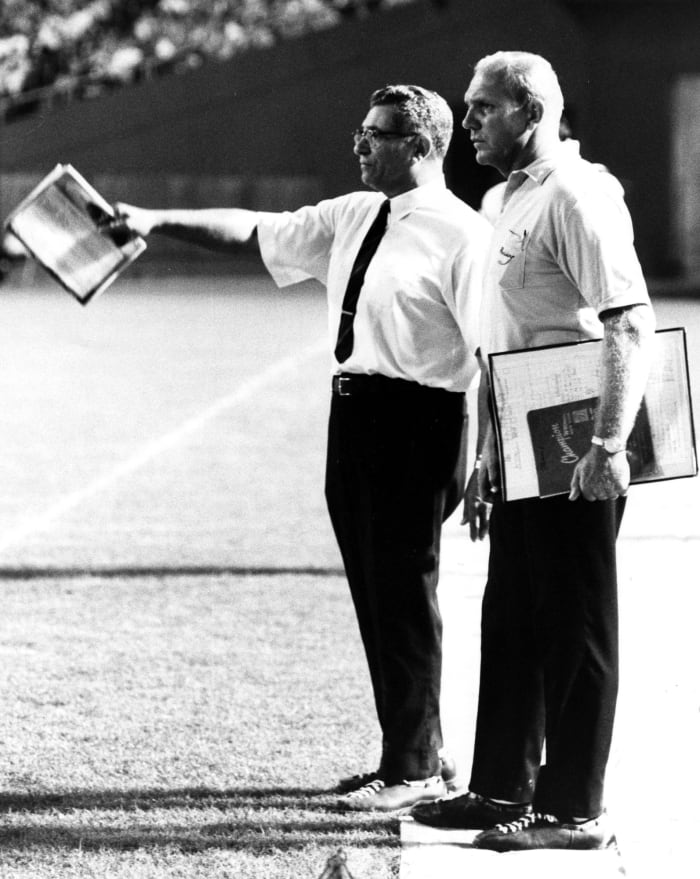
Austin had worked with Vince Lombardi in Green Bay and later served as the Steelers head coach. Hired to rejoin Lombardi in Washington for the 1969 season, Austin became an emergency replacement after Lombardi's September 1970 death from cancer. Austin oversaw a 6-8 season, with future Hall of Fame QB Sonny Jurgensen and future MVP Larry Brown's strong efforts not enough to key a winning mark. A five-game late-season losing streak halted early momentum, and Washington added veteran George Allen, who elevated the team to Super Bowl VII in his second season. Austin hung around as an NFL assistant through the 1985 season.
Charlie Waller, San Diego Chargers (1970)

A Sid Gillman health issue led Waller from offensive coordinator to head coach. Waller had been Gillman's OC since 1966 and went 4-1 as the Chargers' interim boss to close that 1969 season. With Gillman still out of the mix, Waller kept the reins throughout the '70 season. John Hadl and a declining Lance Alworth remained from Gilman's 1960s heyday, but the Chargers were in transition by this point. The 1970 team went 5-6-3. This was before overtime periods could break ties. Gillman felt healthy enough to coach again by 1971, but Waller stayed on, returning to his role as OC. He later served as OC for a Super Bowl-bound Rams team in 1979.
Vince Lombardi, Washington (1969)

Lombardi retired after Super Bowl II, a Packers threepeat and fifth title in seven seasons, but remained in Green Bay's front office. Washington lured Lombardi back to the sideline by offering him a GM role and a stake in the franchise, and the team snapped a 12-year run of losing seasons by going 7-5-2. The team started 4-1-1, and Jurgensen led the still-run-centered NFL with 3,102 passing yards. Hall of Fame wideout Charley Taylor and All-Pro tight end Jerry Smith combined for 17 TDs, as Lombardi reinvigorated the team. A cancer diagnosis cut his tenure short. Lombardi had kept his diagnosis private until days before his death, undergoing two surgeries before passing away September 3, 1970.
Sam Robinson is a sportswriter from Kansas City, Missouri. He primarily covers the NFL for Yardbarker. Moving from wildly injury-prone sprinter in the aughts to reporter in the 2010s, Sam set up camp in three time zones covering everything from high school water polo to Division II national championship games
More must-reads:
- AFC under-the-radar rookies, training camp reporting dates
- Insider shares 'common sense' reason Steelers' T.J. Watt hasn't yet received desired extension
- The 'NFL Offensive Rookie of the Year winners' quiz
Breaking News
Trending News
Customize Your Newsletter
 +
+
Get the latest news and rumors, customized to your favorite sports and teams. Emailed daily. Always free!
PRIVACY POLICY EDITORIAL POLICY CONTACT US
ABOUT YARDBARKER TERMS OF SERVICE
Use of this website (including any and all parts and
components) constitutes your acceptance of these
Terms of Service and Privacy Policy.
This site is for entertainment purposes only.
There is no gambling offered on this site.
Gambling Problem? Call 1-800-Gambler.




